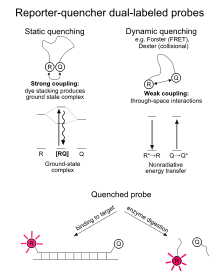Quenching (fluorescence)

Quenching refers to any process which decreases the fluorescence intensity of a given substance. A variety of processes can result in quenching, such as excited state reactions, energy transfer, complex-formation and collisional quenching. As a consequence, quenching is often heavily dependent on pressure and temperature. Molecular oxygen, iodide ions and acrylamide[1] are common chemical quenchers. The chloride ion is a well known quencher for quinine fluorescence. [2] [3] [4] Quenching poses a problem for non-instant spectroscopic methods, such as laser-induced fluorescence.
Quenching is made use of in optode sensors; for instance the quenching effect of oxygen on certain ruthenium complexes allows the measurement of oxygen saturation in solution. Quenching is the basis for Förster resonance energy transfer (FRET) assays.[5][6][7] Quenching and dequenching upon interaction with a specific molecular biological target is the basis for activatable optical contrast agents for molecular imaging.[8][9]
Quenching mechanisms

Förster resonance energy transfer
There are a few distinct mechanisms by which energy can be transferred nonradiatively (without absorption or emission of photons) between two dyes, a donor and an acceptor. Förster resonance energy transfer (FRET or FET) is a dynamic quenching mechanism because energy transfer occurs while the donor is in the excited state. FRET is based on classical dipole–dipole interactions between the transition dipoles of the donor and acceptor and is extremely dependent on the donor–acceptor distance, R, falling off at a rate of 1/R6. FRET also depends on the donor–acceptor spectral overlap (see figure) and the relative orientation of the donor and acceptor transition dipole moments. FRET can typically occur over distances up to 100 Å.
Dexter electron transfer
Dexter (also known as exchange or collisional energy transfer) is another dynamic quenching mechanism. Dexter energy transfer is a short-range phenomenon that falls off exponetially with distance (proportional to e−R) and depends on spatial overlap of donor and quencher molecular orbitals. In most donor-fluorophore–quencher-acceptor situations, the Förster mechanism is more important than the Dexter mechanism. With both Förster and Dexter energy transfer, the shapes of the absorption and fluorescence spectra of the dyes are unchanged.
Exciplex
Exciplex (excited state complex) formation is a third dynamic quenching mechanism.
Static quenching
The remaining energy transfer mechanism is static quenching (also referred to as contact quenching). Static quenching can be a dominant mechanism for some reporter-quencher probes. Unlike dynamic quenching, static quenching occurs when the molecules form a complex in the ground state, i.e. before excitation occurs. The complex has its own unique properties, such as being nonfluorescent and having a unique absorption spectrum. Dye aggregation is often due to hydrophobic effects—the dye molecules stack together to minimize contact with water. Planar aromatic dyes that are matched for association through hydrophobic forces can enhance static quenching. High temperatures and addition of surfactants tend to disrupt ground state complex formation.

See also
- Dark quencher, for use in molecular biology.
- Förster resonance energy transfer, a phenomenon on which some quenching techniques rely
References
- ↑ Acrylamide and iodide fluorescence quenching as a structural probe of tryptophan microenvironment in bovine lens crystallins. Phillips SR, Wilson LJ, Borkman RF. Curr Eye Res. 1986 Aug;5(8):611-9.
- ↑ Fluorescence experiments with quinine James E. O'Reilly J. Chem. Educ., 1975, 52 (9), p 610 doi:10.1021/ed052p610
- ↑ Photophysics in a disco: Luminescence quenching of quinine LouAnn Sacksteder , R. M. Ballew , Elizabeth A. Brown , J. N. Demas , D. Nesselrodt and B. A. DeGraff J. Chem. Educ., 1990, 67 (12), p 1065 doi:10.1021/ed067p1065
- ↑ Halide (Cl-) Quenching of Quinine Sulfate Fluorescence: A Time-Resolved Fluorescence Experiment for Physical Chemistry Jonathan H. Gutow J. Chem. Educ., 2005, 82 (2), p 302 doi:10.1021/ed082p302
- ↑ Peng, X., Draney, D.R., Volcheck, W.M., Quenched near-infrared fluorescent peptide substrate for HIV-1 protease assay, Proc. SPIE, 2006; (6097),
- ↑ Peng, X., Chen, H., Draney, D.R., Volcheck, W.M., A Non-fluorescent, Broad Range Quencher Dye for FRET Assays, Analytical Biochemistry, 2009; (Vol. 388), pp. 220–228. Download PDF
- ↑ Osterman, H., The Next Step in Near Infrared Fluorescence: IRDye QC-1 Dark Quencher, 2009; Review Article. Download PDF
- ↑ Blum G, Weimer RM, Edgington LE, Adams W, Bogyo M (2009) Comparative Assessment of Substrates and Activity Based Probes as Tools for Non- Invasive Optical Imaging of Cysteine Protease Activity. PLoS ONE 4(7): e6374. doi:10.1371/journal.pone.0006374. Download PDF
- ↑ Weissleder R, Tung CH, Mahmood U, Bogdanov A (1999). "In vivo imaging of tumors with protease-activated near-infrared fluorescent probes". Nat. Biotechnol. 17 (4): 375–8. doi:10.1038/7933. PMID 10207887.